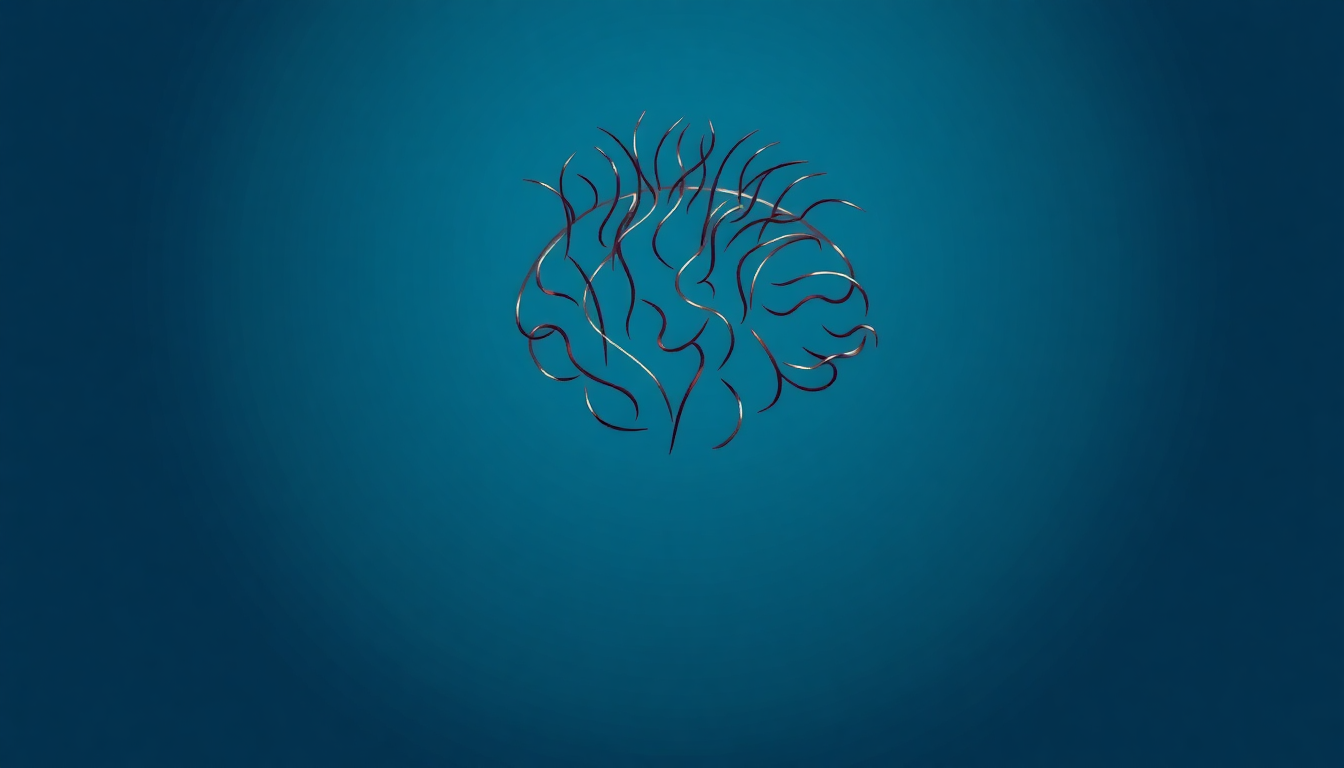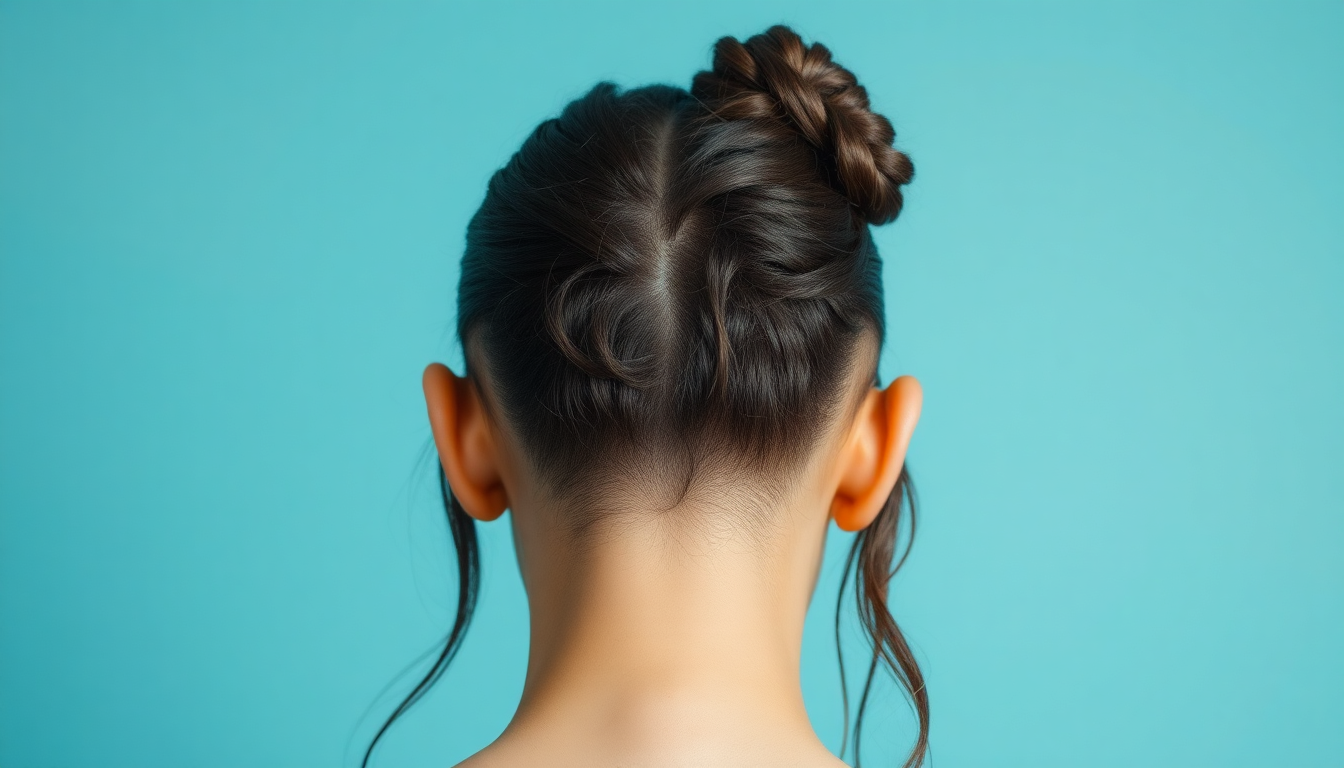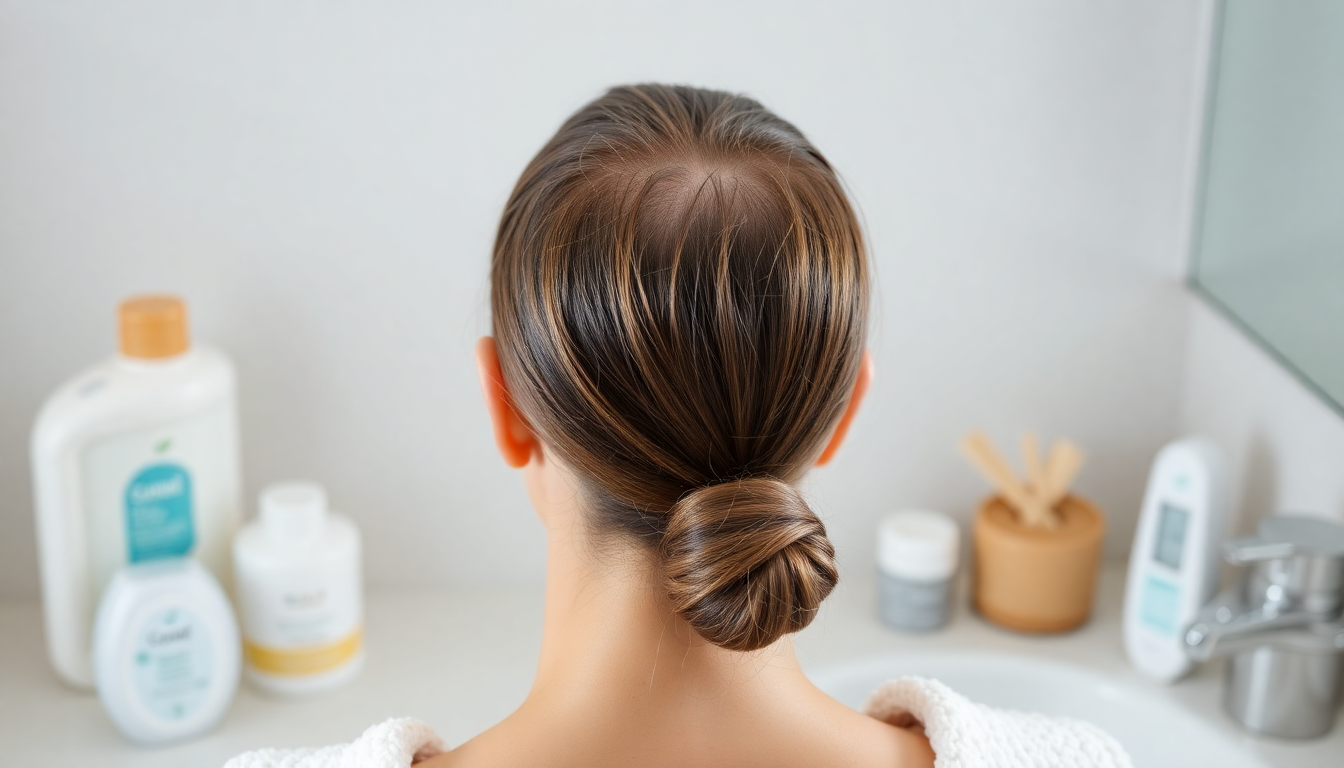Introduction: A Scalp-First Strategy for Real Density Gains
Hair density improvements come from treating the scalp as the skin that surrounds hair follicles—not merely styling the hair. The most effective, sustainable approach blends targeted peptide serums that signal follicular health, prebiotic therapies that calm and rebalance the scalp microbiome, and at-home devices that increase circulation and topical delivery. But the order, frequency and product forms that work best depend strongly on your hair texture, scalp condition and lifestyle.
This comprehensive step-by-step map helps you assess your baseline, select the best peptide actives and prebiotic options, choose devices safely, construct weekly routines, troubleshoot common problems and measure meaningful progress over months.
Step 1 — Deep Scalp & Hair Type Assessment (Take 10–15 Minutes)
Start with a structured assessment. The better you profile your scalp and hair, the more targeted your regimen will be.
- Scalp sebum level: Observe 24–48 hours after shampoo. Is the scalp shiny/oily, normal, dry, flaky or scaly?
- Scalp sensitivity and reactivity: Does your scalp sting or burn after products or color? Do topical actives often cause redness?
- Pattern and timing of hair loss: Is thinning diffuse across the crown, localized (temples, vertex), sudden, or gradual over years?
- Strand thickness and density: Pinch a few hairs — are strands fine, medium, or coarse? How visible is the scalp at part lines?
- Hair texture: Straight, wavy, curly or coily — each requires different product bases and application techniques.
- Recent triggers: Pregnancy/postpartum, stress, illness, medication changes, drastic weight loss, or chemical treatments can inform likely causes.
If you suspect a medical cause (sudden shedding, scarring, or patches without regrowth), see a dermatologist before investing in a long-term regimen.
Step 2 — Understand Peptide Serums: Types, Mechanisms & How to Choose
Peptides are short chains of amino acids used in topical scalp products to modulate cell behavior, support follicle anchoring and improve scalp environment. They are not a cure-all, but when chosen and used correctly they can meaningfully support density when paired with good compliance and other supportive measures.
Common Peptides to Look For
- GHK-Cu (copper peptide): Often used for tissue remodeling and skin repair; many scalp serums include this for barrier support and signaling.
- Acetyl Tetrapeptide-3: Marketed for scalp anchoring and follicle support; commonly found in hair-targeted formulations.
- Biotinoyl Tripeptide-1: A peptide designed to localize to follicles and support shaft anchoring.
- Procapil (blend): A marketed complex combining a peptide with botanical components to reduce follicle sensitivity to DHT and support anchoring; presented in many scalp serums.
- Myristoyl Pentapeptide-17 and related peptides: Used in serums aiming to improve the visible fullness of hair by signaling keratinocyte behavior.
Note: Brands may use trade names and complexes; read ingredient lists and prioritize transparency over hype. Avoid products that claim overnight miracles—reality is measured in months.
How to Match Peptides to Scalp/Hair Profiles
- Oily scalps: Choose water-based, non-comedogenic peptide serums with light carriers (hexylene glycol, propanediol) to avoid buildup.
- Dry or flaky scalps: Use peptide serums formulated with humectants (glycerin, low-molecular-weight hyaluronic acid) and supporting lipids to preserve barrier.
- Sensitized scalps: Patch-test fragrance-free peptide products; consider starting frequency at every other day.
- Curly/coily hair: Use richer peptide serums that pair well with protective oily pre-poo techniques, and target the scalp rather than soaking strands.
- Genetic-pattern thinning: Use peptides as adjuncts alongside clinically-proven medical treatments where appropriate; peptides can improve scalp health and complement medical therapies.
Step 3 — Prebiotic Therapies: Why the Microbiome Matters and Which Ingredients to Use
The scalp microbiome influences inflammation, oil balance and barrier function. Prebiotic therapies feed beneficial microbial communities, helping to reduce irritation and flaking that can interfere with hair retention and follicle health.
Prebiotic Ingredients to Look For
- Alpha-glucan oligosaccharide: A commonly used prebiotic ingredient in scalp-friendly cleansers and leave-ons.
- Inulin / Fructooligosaccharides (FOS): Plant-derived prebiotics that support beneficial microbes.
- Polyglutamic acid blends and fermented extracts: Often included to support barrier and hydration in microbiome-focused formulas.
How to Use Prebiotic Therapies Safely
- As a cleanser: Use prebiotic shampoos 2–3x per week for oily or seborrheic tendencies. For dry scalps, choose low-foam, sulfate-free formulations.
- As a leave-on: Prebiotic scalp serums and balms can be used every other day or daily depending on formulation and tolerance.
- Combining with actives: Use prebiotics to calm and prepare the scalp; apply peptide serums post-wash on a clean, damp scalp for better uptake.
Step 4 — At-Home Devices: Which Devices, How They Work, and Safety Guidelines
At-home devices can accelerate results when used properly. They fall into a few categories: light therapy (LLLT), mechanical stimulation (massagers), and controlled micro-injury (microneedling). Each has distinct effects and compatibility with topical layers.
Low-Level Laser Therapy (LLLT) / Red Light
- How it helps: LLLT can increase local circulation and cellular activity in the scalp, which may support hair growth cycles over time.
- Typical specs: Many effective consumer devices operate in red wavelengths around 630–670 nm; higher-end devices may add near-infrared bands (800–850 nm).
- Usage: Common protocols: 15–30 minutes per session, 3–5 times weekly. Consistency is key.
Microneedling (Home vs. Clinical)
- Mechanism: Controlled micro-injury stimulates wound-healing pathways and can improve topical absorption.
- Needle depths: Home rollers/stamps: 0.25–0.5 mm (safer, lower penetration). Clinical in-office procedures: 1.0 mm and above for deeper dermal remodeling—only under professional supervision.
- Frequency: Home microneedling: every 1–2 weeks depending on depth; professional sessions less frequently with greater depths.
- Safety: Avoid microneedling over infected or inflamed scalp, open sores, or severe dermatitis. Strict hygiene is essential to avoid infections.
Electric Scalp Massagers & Vibration Devices
- Provide gentle mechanical stimulation to boost microcirculation and reduce tension.
- Great for daily use, compatible with oils and leave-on serums when used gently.
Step 5 — Layering Order: How to Apply Cleansers, Prebiotics, Peptides & Devices
Proper order matters to avoid irritation and to maximize absorption. Use this simple hierarchy:
- Cleanse (prebiotic shampoo or gentle cleanser).
- Towel-dry so the scalp is damp but not dripping.
- Apply leave-on prebiotic treatments if indicated (unless your prebiotic is the cleanser).
- Apply peptide serum(s) to targeted areas; allow to absorb.
- If using LLLT, deliver light therapy either before applying serums (cleaner surface) or after, depending on device guidance. When in doubt, perform device in the morning and serums at night.
- If microneedling is used, perform microneedling first, then apply peptide serums only if the product and device instructions permit; otherwise wait 24 hours to reduce irritation risk.
Step 6 — Practical Weekly Routines (Extended & Timed Examples)
The following templates are detailed, time-stamped weekly routines you can adapt. Modify frequency based on tolerance and results.
Routine A — Oily Scalp with Diffuse Thinning (Time-friendly)
- Morning: Quick rinse or water-only scalp refresh if needed; LLLT device (15–20 minutes) on Mondays/Wednesdays/Fridays.
- Evening: Prebiotic shampoo Tuesday/Thursday/Saturday; after towel-drying apply lightweight peptide serum to thinning zones and gently massage 2–3 minutes. Use a non-comedogenic leave-on if extra hydration is required.
- Daily: 1–2 minutes of fingertip scalp massage or short electric massager to stimulate circulation and disperse sebum.
Routine B — Dry, Fragile Hair with Breakage
- Sunday & Thursday: Hydrating, sulfate-free prebiotic shampoo followed by a rich conditioning mask or pre-poo oil.
- After wash (both days): Apply peptide serum with hydrating base to damp scalp and follow with a restorative leave-in on lengths (not heavy oils on the scalp).
- Weekly: Short at-home microneedling session (0.25–0.5 mm) every 10–14 days if tolerated; follow manufacturer guidance on topical application after needling.
- Daily: Protective styling, minimal heat, and silk/satin pillowcase to reduce mechanical breakage.
Routine C — Curly/Coily Hair Prioritizing Density
- Weekly wash day: Low-foam or co-wash prebiotic cleanser. Apply a concentrated peptide serum to scalp sections while hair is wet; follow with deep conditioner and gentle detangling.
- Twice weekly: Scalp massage with a light oil (jasmine, jojoba) as a pre-poo before cleansing to improve follicle condition and protect strands.
- Monthly: LLLT sessions (2–3 times monthly) if scalp is tolerant, scheduled on non-wash days to avoid complicating product layering.
Step 7 — Selecting Products: A Shoppers Checklist
Use this checklist at checkout to separate meaningful formulations from marketing claims.
- Ingredient transparency: Is the peptide named (e.g., GHK-Cu, acetyl tetrapeptide-3) or just "peptide complex"?
- Formulation base: Water-based for oily scalps, lipid/humectant-rich for dry scalps.
- Clinical or laboratory support: Look for brands that cite clinical testing or publish ingredient concentrations (not mandatory, but helpful).
- Compatibility with devices: If you plan to microneedle, ensure the serum is recommended for post-needling use.
- Scent and preservative system: Fragrance-free options reduce irritation risk; check preservative choices if you have sensitivities.
- Return policy and reviews: Long-term consistency is required, so favorable return terms and verified user reviews are important signals.
For a curated selection of peptide serums, microbiome-friendly cleansers and device-compatible formulas, consider exploring specialist lines like Eelhoe Cosmetics peptide serums and prebiotic scalp therapies.
Step 8 — Tracking Progress: Metrics That Matter
Improvements can be subtle. Use consistent, objective measures to evaluate whether your routine works:
- Photography: Take standardized photos every 4 weeks (same camera, distance, lighting, and parting).
- Shedding counts: Collect loose hairs after a shower for a simple weekly record.
- Scalp condition journal: Record itching, flaking, oiliness, and sensitivity weekly.
- Texture/density notes: Note if hairs feel thicker at the root, if new baby hairs appear, and whether part lines narrow.
- Timeframes: Expect cosmetic differences in 8–12 weeks and fuller changes in 4–6 months; some people require longer depending on hair cycles and underlying causes.
Troubleshooting — What to Do When Things Stall or Go Wrong
- Irritation after a new serum: Stop immediately. Patch-test alternatives. If irritation resolves, reintroduce at lower frequency or seek fragrance-free/simpler formulas.
- Increased shedding initially: Some users see a transient shed when introducing active regimens; if shedding is rapid or prolonged, consult a dermatologist.
- Plateau after 3–6 months: Reassess compliance, device use, and medical causes. Consider alternating peptides or adding a different modality (e.g., LLLT) while consulting a specialist.
- Build-up or greasy residue: Swap to lighter carriers or rinse more thoroughly and reduce oil-based scalp treatments.
- Dandruff or seborrheic symptoms: Use targeted medicated shampoos intermittently and maintain prebiotic maintenance between medicated treatments; see a clinician if severe.
Case Studies & Example Timelines
Below are hypothetical, evidence-informed timelines to set realistic expectations:
- Case 1: Mild diffuse thinning, oily scalp: Start prebiotic cleanser + lightweight copper peptide serum + LLLT 3x/week. At 8 weeks, reduced scalp oil and less scalp show-through. By month 4, faint new vellus hairs at crown; by month 6 improved part density.
- Case 2: Postpartum shedding with dry scalp: Focus on hydration, barrier-supporting peptide serum and weekly gentle microneedling (0.25 mm) if tolerated. Expect initial shedding resolution within 2–3 months; gradual density recovery over 6–12 months.
- Case 3: Genetic-pattern thinning: Use peptides and LLLT as adjuncts to clinician-prescribed therapies. Noticeable cosmetic improvements often take 4–6 months; maximal combined outcomes may require longer and medical oversight.
Extended FAQ
- Can I layer multiple serums? Yes if formulations are compatible. Avoid mixing acids or irritating actives together. When in doubt, space applications (morning vs evening).
- Is microneedling safe with peptides? Micro-needling can increase peptide absorption but also risk irritation. Use only products labeled safe for post-needling use or follow a 24-hour wait period.
- How do I choose between LLLT and microneedling? LLLT is low-risk and suitable for long-term home use. Microneedling gives a stronger local stimulus but has higher infection/irritation risk if not performed properly.
- Are oral supplements necessary? Not always. If you have nutritional deficiencies (iron, vitamin D, B12), supplements may help; get labs checked and follow medical advice.
Shopping Guide: Reading Labels, Avoiding Pitfalls
When shopping online or in-store, use these label-level checks:
- Look for named active peptides early in the ingredient list (higher concentration is often listed earlier).
- Check the product form: is it an oil, water-based serum, lotion or leave-on tonic? Match the form to your scalp type.
- Search for "device-compatible" if you plan to microneedle or use LLLT—some products are formulated specifically for better penetration or post-device use.
- Read consumer reviews critically: look for consistent comments about tolerance and long-term changes rather than one-off claims.
If you want a place to begin with curated, device-friendly peptide serums and microbiome-aware cleansers, explore options at Eelhoe Cosmetics peptide serums and prebiotic scalp therapies. Their targeted formulas are designed to fit into device-assisted routines and are a useful starting point for density-focused programs.
Advanced Notes: Combining with Medical Treatments
If you are using prescription treatments (topical minoxidil, oral finasteride, spironolactone, or other therapies), peptides, prebiotics and devices can be complementary. However:
- Coordinate timing and monitor for irritation. For example, avoid applying irritating tonics immediately after microneedling.
- Inform your dermatologist about your at-home devices and serums so they can advise safe combinations.
- For autoimmune-related hair loss (alopecia areata), medical therapies are primary; topicals and devices may be adjunctive but are not replacements.
Final Checklist: What to Start With This Week
- Perform the 10-minute scalp and hair assessment and take baseline photos.
- Choose one prebiotic cleanser and one peptide serum matched to your scalp type.
- If you plan to use a device, read all instructions, register the device (if applicable), and begin with the manufacturers recommended schedule.
- Create a 3-month plan in your calendar for product use and photo checkpoints.
Conclusion — Small, Consistent Actions Yield Real Density Gains
Improving hair density is a marathon, not a sprint. The best outcomes come from a curated routine that matches peptide serums, prebiotic therapies and devices to your individual hair type and scalp needs. Start with assessment, choose products thoughtfully, apply in the correct order, and measure progress consistently. If youre looking for a curated starter selection that combines peptide serums and prebiotic scalp care with device-friendly formulations, check out the targeted options at Eelhoe Cosmetics. Their range is designed to support density-focused scalp programs and can simplify your shopping as you begin a consistent routine.
Disclaimer: This article is for informational purposes and does not replace professional medical advice. For sudden hair loss, scarring, signs of infection, or underlying medical conditions, consult a dermatologist or qualified healthcare provider before starting new treatments.




Leave a comment
All comments are moderated before being published.
This site is protected by hCaptcha and the hCaptcha Privacy Policy and Terms of Service apply.